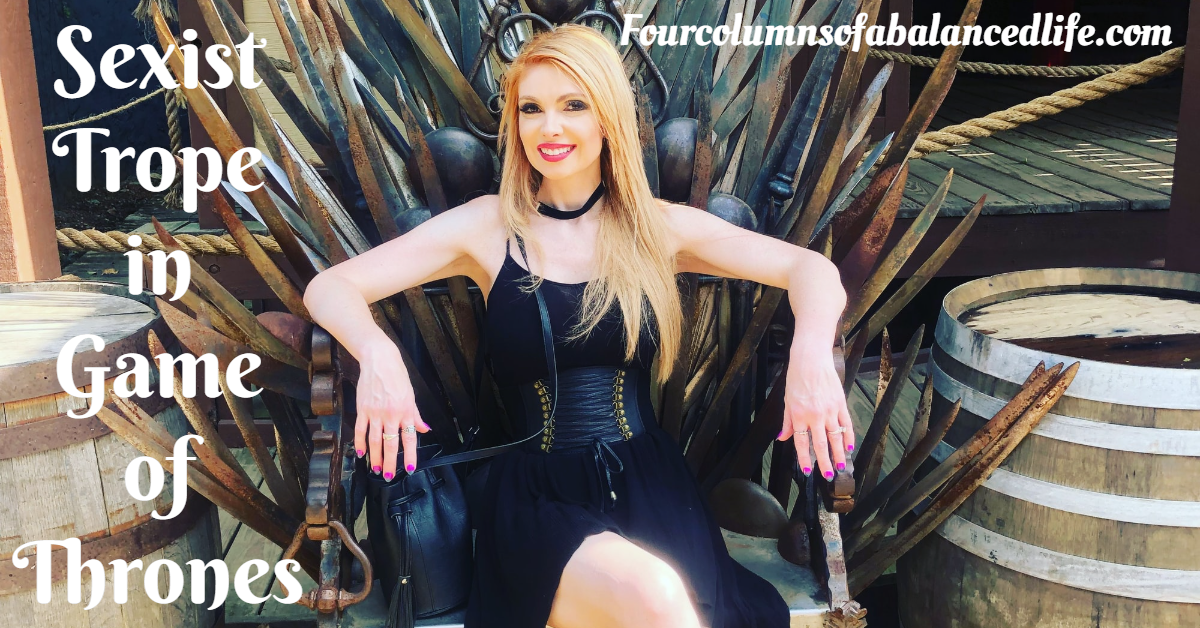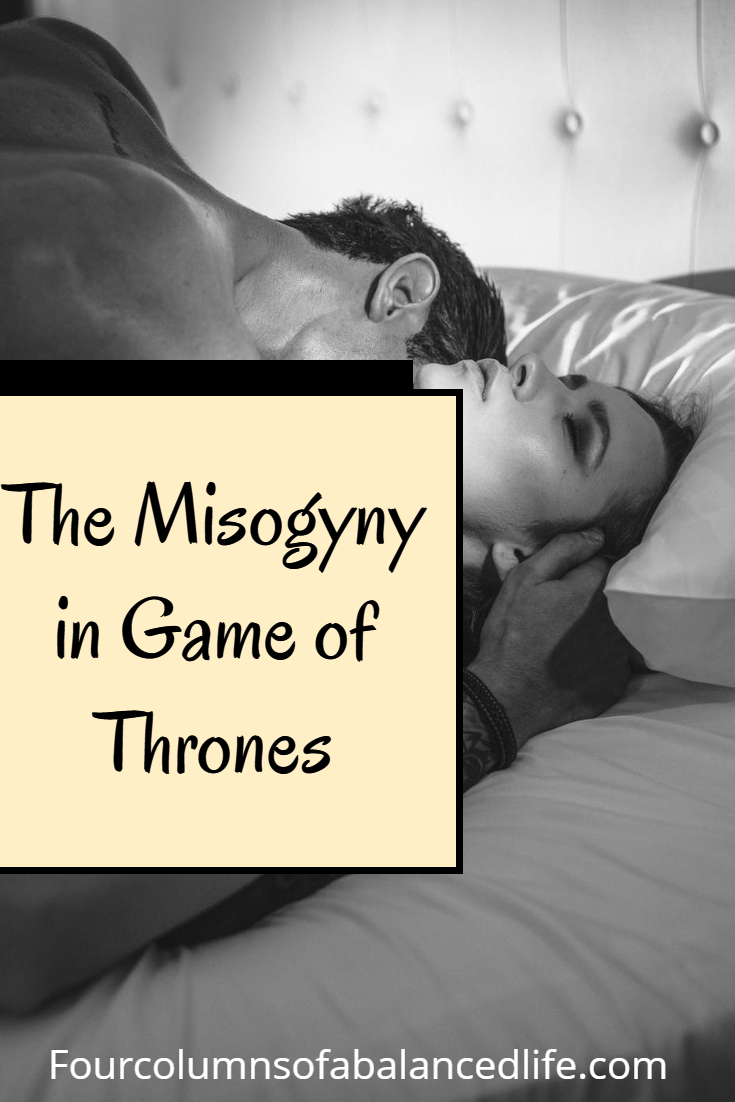Sexist Trope in Game of Thrones

Game of Thrones (GOT) is an American fantasy drama TV series by HBO based on A Song of Ice and Fire. GOT has a huge following and a robust international fan base. GOT is going to be known as the best TV series ever done and received 59 Primetime Emmy’s, a Peabody Award, Golden Globe Award, and three Hugo Awards.
My goal in writing this post is to question whether the amount of gratuitous one-sided female nudity and sexual violence towards women was really necessary to the plot.
The first four seasons had 30 minutes of nudity
31 out of 40 episodes featured a nude scene. The first four seasons had 30 minutes of nudity.
Sansa Stark is raped and Reek is forced to watch. Daenerys is raped by Khal Drogo. Cersei Lannister is raped by her own brother Jaime. The sexual violence reaches its nadir when Joffrey orders Sansa half-stripped and beaten. He then demands that prostitutes badger each other at the point of a crossbow for his pleasure. Myles McNutt came up with the word ‘sexposition’ for Game of Thrones contrived and baseless female nudity.
The creators of the show wanted to show war as it really is and the stark truth of medieval society. Dysentery was common in the medieval ages but not one character succumbs to it. The streets were filled with plague-bearing rodents and fleas. We do not see any of this in Game of Thrones. Yes, rape is common in war. GOT only shows lithe and lissome attractive women being the target of rapists. GOT uses frontal nudity to lure you into an otherwise riveting narrative. The one-minute-long sex scenes littered the series.
Game of Thrones misogyny and sexism show a serious lack of awareness. A decade from now, an audience will not tolerate that kind of chauvinism and braggadocio in their entertainment. The intendancy towards women has defiled the series. There is nothing empowering about showing a nude woman trying to please her master.

Was the Middle Ages really sexist?
GOT talks about Yara Greyjoy, Brienne of Tarth, Sansa Stark, Cersei Lannister, and Daenerys Targaryen taking over.
Sarah Durn agrees that women did not have the right to active or passive suffrage but their position got worse after the Middle Ages. Joan Kelly-Gadol argues that the Middle Ages had some amazing female leaders who had more power than GOT and did not raze any enemy city to dust.
Society in the Middle Ages was focused on land. Power rested on how much land you owned. Women received land through inheritance or marriage. Crusades called all the men to war. The women inherited the land when their brother, father, or husband died. Brigitte Bedos-Rezak posits that single women who owned land signed under their names.
The Renaissance led to the upsurge of cities, individualism, and the disruption of family. The cabals that resulted consisted of only men and women were pushed out and with that the power from the land.
Power can be warranted emotionally, mentally, financially, physically, legally, and from the religious establishment. The Catholic Church held all the power in medieval society. The Catholic Church allowed women to become nuns and were sainted. However, the rise of Elizabeth I, Eleanor of Aquitaine, and Joan of Arc challenged the status quo of the Catholic Church. The trials of witches during the Renaissance eradicated the power of women. The thin line between a saint and a witch was blurred.
We look at the Middle Ages through the lens of the Victorians because of the power they had. The epoch under the Victorians was famous for women having no rights in business, ownership, or under the eyes of the law. The Victorians believed that ‘women would perish without male protection’. Is there a reason why we call them the dark ages?
The Age of Enlightenment, Imperialism, and the industrial revolution focused on jingoism rather than on women’s rights. The Victorians ignored the scars of the Industrial Revolution which consisted of colonialism, child labor, racism, and repression. The focus became on the Medieval Ages.
Game of Thrones never portrays women as three-dimensional
GOT never portrays women as three-dimensional. They are the backup to the male protagonist. Men experience anguish and suffering. Jaime Lannister lost his kids; Davos is grief-stricken that Shireen is burned alive. Davos becomes strong and resolute to revenge. However, when the female characters experience loss, they go downhill. Cersei is evil making foolhardy and brutal choices. She is not capable of making choices because she is devoured by grief.
Daenerys is shown as scared that the very throne that she craves will be taken by Jon Snow. She has been belittled, underrated, molested, and mistreated. However, she is shown as a victim. Male characters can withstand loss, pain, and betrayal at every corner and they have laser focus and deep strength to deal with issues. The female characters are not shown this way. Daenerys is upset that Rhaegal is killed by Euron. She could have led the attack from behind but she is shown with no reason or intelligence and acts on a whim. To add insult to injury Daenerys is killed by Jon Snow who is her cousin and ex as they embrace. We have one of the principal female protagonists killed abruptly.
Cersei and Daenerys upbringing was cruel and lacked love. To make matters worse they were manipulated, used, abused, raped, degraded, and made to feel unworthy. The only way to react to that treatment is to internalize it and spit it out onto others. Daenerys wants to be the Joan of Arc. However, all the circumstances lead her to become jaded, bitter, and cynical. Sansa is raised in a loving family but as soon as she gets married the life of abuse starts.
A ship needs an anchor. We all need anchors in our life. Cersei and Dany did not have any anchors. GOT while trying to be realistic about the Medieval Ages, does not portray what a dysfunctional upbringing can do to a woman.
Sansa, Daenerys, and Cersei are contending for the throne. However, GOT only shows them as pitiful women who are only sexual beings.


I agree completely. I watched the first couple of seasons and read the books, but the overly violent and sexy content always left me feeling like I needed a shower. I guess it’s the trends now but I’m not too into it.
I agree, I struggled to really get into it (despite having all of my friends talking about how much they adore it) because it was hard to look past the way that women were portrayed. I am okay with violence and even with accurately depicting history in the sense that women didn’t have the opportunities that they do today, but it felt like they were pushing it as far as possible to add nudity and sexual content to draw in a specific audience.
Thank you for your thoughtful review of this aspect of the show. I never got into it, and the few times I watched a bit of it I noticed some of the points you made. Thanks for sharing with the world!
I totally agree and is a huge factor why I could never get into the show. This is such a fantastic, in depth analysis of the series. Thanks so much for sharing!